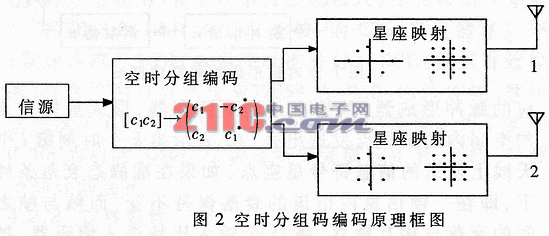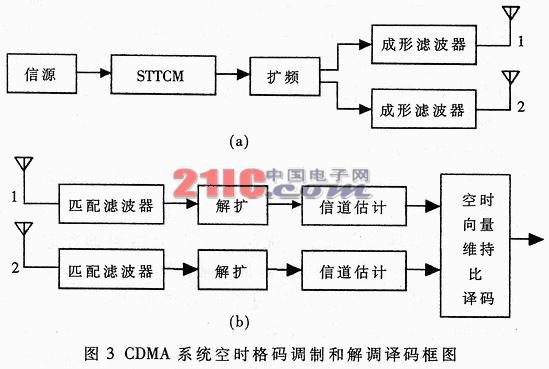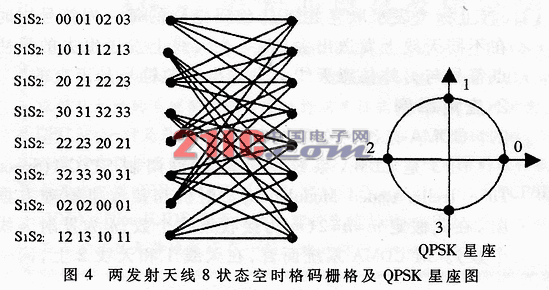Abstract: This paper introduces the structure and coding principles of space-time codes based on transmit diversity, summarizes and analyzes the application and performance characteristics of space-time codes based on transmit diversity in mobile communications, and discusses its research direction and development prospects.
The concept of transmit diversity is derived from receive diversity technology. In order to reduce the effect of signal fading, multiple independent antennas or related antenna arrays are used to provide a copy of the transmitted signal to the receiving end in the form of spatial redundancy. Diversity transmission utilizes the irrelevance of the signals transmitted by different base stations or antennas at different positions in the same base station to reach the mobile station. With the help of the Rake diversity receiving function of the mobile station, the signals sent by different antennas or different base stations are received and then diversity combined to improve the system performance.
Space-time coding (STC) is a new coding and signal processing technology that has appeared in the field of mobile communications in recent years. It uses multiple antennas to transmit and receive information at the same time at the transmitter and receiver. It is introduced between the signals transmitted by different antennas. The time domain and the air domain are related, and the two-dimensional information of the time domain and the air domain is comprehensively utilized to perform diversity reception at the receiving end. Space-time coding combines space diversity, frequency diversity and time diversity to improve the communication quality and quantity of multipath fading channels from the perspective of the overall communication system.
figure 1
Due to the increase of mobile users, mobile communication services have expanded from pure voice services to multimedia services, and wireless spectrum resources have become increasingly tense. Pursuing the highest possible spectrum utilization rate has become a research hotspot and focus. For a long time, people have been devoted to the development of efficient coding, modulation and signal processing technologies to improve the efficiency of the wireless spectrum. Space-time coding technology based on transmit diversity is one of the important schemes that can effectively improve the utilization rate of wireless spectrum. This is a fruitful achievement made on the basis of people's understanding of the importance of transmit diversity and space-time coding.
1 Space-time code coding principle based on transmit diversity
Space-time codes based on transmit diversity are divided into space-time lattice codes STTC (Space-TIme Trellis Code) and space-time block codes STBC (SpaceTIme Block Code), and their coding principles are as follows.
1.1 Space-time trellis code (STTC)
Space-time lattice codes are a type of space-time codes that combine lattice codes with multiple antennas. Figure 1 shows a space-time lattice coding scheme. At the kth moment, there are b bits of information input into the encoder, and the encoder also includes several memories for storing k-1, k-2, .... At the time of input information, the number of these memories is determined by the number of states of the coding grid. The input information has n outputs after passing through the channel encoder, and each output takes a value in the LatTIce Z2b, and then each output is sent to the corresponding pulse shaper, and its output is then sent to the modulator, forming a scale of 2b The constellation points in the space are sent out. Ckj represents the information symbol constellation point transmitted on the i-th antenna at the k-th time. If under quasi-static fading conditions, that is, the fading of the channel remains unchanged within a frame of information, and the fading between frames is also independent of each other, lb input bits are sent to the encoder, and these bits are divided into l Group, b bits in each group, rearrange the string symbol constellation point code words C11C12 ... C1nC21C22 ... C2n ... Cl1Cl2 ... Cln. Through proper coding, this space-time coding scheme can obtain the best diversity gain and coding gain, respectively. 
1.2 Space-time block code (STBC)
To reduce decoding complexity, AlamouTI proposes a transmission method using two transmit antennas. On this basis, Tarokh extended it using the principle of generalized orthogonal design, and proposed the concept of space-time block codes.
Figure 2 is a block diagram of space-time block code encoding. The input information is first divided into a group of two symbols [C1, C2]. After space-time block coding, the two antennas simultaneously transmit two symbols in two symbol periods. In the first cycle, antenna 1 sends cl and antenna 2 sends c2; in the second cycle, antenna 1 sends -c2 *, and antenna 2 sends c1 * (superscript * means complex conjugate). Each column of symbols of the coding matrix is ​​sent on different antennas at the same time. The constellation point symbols sent on one antenna are orthogonal to the symbols sent on any other antenna.
2 Application examples
2.1 Space-time trellis code modulation of CDMA system
Figure 3 is a block diagram of the principle of a space-time trellis coded modulation (STTCM) transmitter and receiver of a CDMA system. It is assumed here that m = n = 2 (m is the number of receiving antennas and n is the number of transmitting antennas). For the CDMA system, on antenna 1 and antenna 2, the same user data part uses the same spreading code, but uses different pilots. 
FIG. 4 is a two-antenna 8-state space-time trellis code grid and QPSK constellation diagram (that is, space-time coding grid diagram and constellation diagram). The convolutional coding is (2, 1, 3), the code rate is 1/2, the number of convolutional code states is 8, and the frame structure is pilot symbols plus data. Among them s1 means sending on the first antenna, s2 means sending on the second antenna. The theory proves that the space-time code can obtain the optimal characteristics, that is, the maximum diversity gain and coding gain can be obtained. The decoding of space-time trellis codes can use VITERBI decoding or BCJR-MAP algorithm.
2. 2 WCDMA space-time block code transmit diversity (STTD)
Due to the relatively simple decoding algorithm and better performance of space-time block codes, WCDMA downlink open-loop transmit diversity uses space-time block coding technology. The principle block diagram of WCDMA's space-time block code transmit diversity STTD (SpaceTime transmit Diversity) is shown in Figure 5. The source bit stream is first subjected to STTD encoding and is divided into A and B channels. Each channel is further divided into I and Q channels. The channel code and the long scrambling code are used for spread spectrum modulation, and finally the orthogonal carrier modulation is performed from antenna A , B launch. 
After STTD encoding, each channel is changed from serial to parallel and QPSK encoded. In fact, the signal is converted into a two-bit complex signal transmission. QPSK carrier modulation is performed on the baseband signal of formula (2) and expressed by complex variables, and the transmitted signals on antenna A and antenna B are:
s1 = b0 + jb1; s2 = b2 + jb3 (1)
Assuming that the two antennas are independent of each other, and the impulse responses of the two independent fading channels are pill h1 and h2, respectively, the received signal is:

Carry out QPSK carrier modulation of the baseband signal of formula (2) and express it with complex variables. The transmission signals on antenna A and antenna B are:
TA1 = s1 · (cos (wct) Wki + jsin (wct) Wkq)
TA2 = s2 · (cos (wct) Wki + jsin (wct) Wkq)
TB1 = -s2 · (cos (wct) Wki + jsin (wct) Wkq)
TB2 = -s1 · (cos (wct) Wki + jsin (wct) Wkq)
Assuming that the two antennas are independent of each other, and the impulse responses of two independent fading channels are h1 and h2, respectively, the received signal is:

Carry on the carrier and spread spectrum demodulation of formula (3), obtain the digital signals of I and Q after demodulation, send to the maximum likelihood decision device, and perform maximum likelihood decoding.
3 Performance analysis of space-time codes based on transmit diversity
Transmit diversity-based space-time code set Transmit diversity is integrated with space-time coding, has better frequency and power efficiency, greatly improves the information capacity and information rate of mobile communication systems, and makes full use of wireless spectrum resources. Experimental simulation shows that the space-time code frequency band utilization based on transmit diversity can reach 20 ~ 40bps / Hz, and the space-time trellis code and space-time block code can reach the maximum diversity gain provided by the system.
Since the space-time trellis code considers the correlation between the front and back inputs, in addition to the diversity gain, it can also obtain a certain coding gain without sacrificing the system bandwidth. Therefore, it has better performance than space-time block codes and strong anti-fading ability. The main disadvantage of the lattice-shaped code is that it is more difficult to search for a good code when encoding, and the decoding process is also more complicated. For a space-time trellis code with a fixed number of transmit antennas, its decoding complexity (measured by the number of states in the decoder grid) will increase exponentially as the transmission rate increases. The other two shortcomings of space-time lattice codes are: the maximum posterior probability of soft input and soft output MAP algorithm decoding has a large decoding delay, which is unbearable for voice services; it is difficult to optimize the code and serial cascade The system's STYC code optimization criteria have not yet been established. Because of the above problems, the practical process of space-time lattice codes is relatively slow, and it is difficult to implement.
Space-time block codes are easy to construct and simple to decode. Through code orthogonal design, transmit diversity obtains two remarkable characteristics: one is the orthogonal design, so that the system provides the maximum transmission rate in full diversity, so there is no loss of transmission bandwidth; the second is to apply orthogonality between the columns of the coding matrix Performance, the receiving end obtains the best signal-to-noise ratio and can decode with the simplest maximum likelihood decoding algorithm. The main disadvantage of space-time block codes is limited performance improvement. It cannot be improved by increasing the number of states like space-time trellis codes, and the anti-fading performance is not ideal. In addition, it is necessary to know the accurate channel fading coefficient when decoding, which requires the transmitting end to transmit different pilot sequences, and the receiving end uses a large number of channel estimation operations to achieve the space-time diversity effect. When space-time block codes are used in conjunction with interleaving techniques, performance is greatly improved. Although space-time block codes based on orthogonal design theory cannot obtain coding gain, they have low decoding complexity and may also obtain maximum transmit diversity gain, so they have been officially included in the WCDMA proposal.
Figure 5
4 Research direction and development prospect of space-time codes based on transmit diversity
In the design of space-time trellis codes, inner product distance and Hamming distance are mainly used. How to find more suitable design criteria in space-time trellis coding is a direction worthy of in-depth study. V. Although Tarokh et al. Gave the performance limit under the Rayleigh Ricean channel, they still lacked further capacity analysis of the fading channel. The combination of space-time trellis codes and other technologies (such as the combination of smart antennas, multi-user detection and multiple trellis code modulation MTCM) has become a research hotspot.
Orthogonal design is the core of space-time block codes. Although there are real orthogonal and complex orthogonal design schemes, there is still a need to study orthogonal design. In order to make the receiver of the other party have the best performance, combining space-time block codes with power control to adjust the power and phase of a single transmitting antenna is also one of the research directions. Furthermore, because space-time block codes have relatively simple decoding algorithms and better performance, there is a possibility of combining space-time codes with other cutting-edge technologies. For example, Orthogonal Frequency Division Multiplexing (OFDM) is one of the hotspots in research today. Combining space-time block codes with OFDM can not only achieve excellent performance, but also effectively reduce the difficulty of OFDM blind channel estimation.
Space-time codes based on transmit diversity is a promising key technology proposed in recent years. In the current situation of increasing spectrum resources, people must constantly tap the potential of spectrum resources to meet the growing demand for mobile multimedia communications services. Research shows that space-time codes based on transmit diversity are one of the most effective methods to improve the utilization rate of wireless spectrum, and will be widely used in future mobile communication systems. But at the same time, we should also see that there are still many areas to be improved in the theoretical analysis of space-time codes, and how space-time codes based on transmit diversity can effectively interact with smart antenna technology, multi-user detection technology, equalization technology, MTCM technology, OFDM Combining technology, there is still a lot of work to be done. In view of this, we should vigorously strengthen research work in these areas, continue to make breakthroughs in core technologies, and continue to mature and improve in theory, so that in future mobile communication systems, space-time codes based on transmit diversity are used to improve spectrum utilization. Play a more prominent role.
Hybrid Stepper Motor,Stepper Motor,Standard Hybrid Stepping Motor,Linear Hybrid Stepping Motor
Changzhou Sherry International Trading Co., Ltd. , https://www.sherry-motor.com